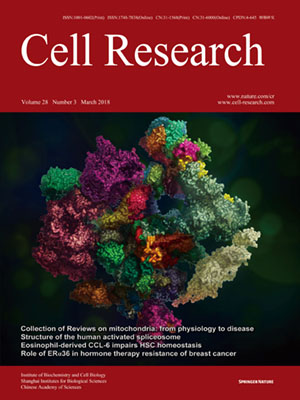
Volume 28, No 3, Mar 2018
ISSN: 1001-0602
EISSN: 1748-7838 2018
impact factor 17.848*
(Clarivate Analytics, 2019)
Volume 28 Issue 3, March 2018: 359-373
ORIGINAL ARTICLES
Diverse modes of clonal evolution in HBV-related hepatocellular carcinoma revealed by single-cell genome sequencing
Meng Duan, Junfeng Hao, Sijia Cui, Daniel L Worthley, Shu Zhang, Zhichao Wang, Jieyi Shi, Longzi Liu, Xiaoying Wang, Aiwu Ke, Ya Cao, Ruibin Xi, Xiaoming Zhang, Jian Zhou, Jia Fan, Chong Li & Qiang Gao
Correspondence:
Hepatocellular carcinoma (HCC) is a cancer of substantial morphologic, genetic and phenotypic diversity. Yet we do not understand the relationship between intratumor heterogeneity and the associated morphologic/histological characteristics of the tumor. Using single-cell whole-genome sequencing to profile 96 tumor cells (30-36 each) and 15 normal liver cells (5 each), collected from three male patients with HBV-associated HCC, we confirmed that copy number variations occur early in hepatocarcinogenesis but thereafter remain relatively stable throughout tumor progression. Importantly, we showed that specific HCCs can be of monoclonal or polyclonal origins. Tumors with confluent multinodular morphology are the typical polyclonal tumors and display the highest intratumor heterogeneity. In addition to mutational and copy number profiles, we dissected the clonal origins of HCC using HBV-derived foreign genomic markers. In monoclonal HCC, all the tumor single cells exhibit the same HBV integrations, indicating that HBV integration is an early driver event and remains extremely stable during tumor progression. In addition, our results indicated that both models of metastasis, late dissemination and early seeding, have a role in HCC progression. Notably, early intrahepatic spreading of the initiating clone leads to the formation of synchronous multifocal tumors. Meanwhile, we identified a potential driver gene ZNF717 in HCC, which exhibits a high frequency of mutation at both single-cell and population levels, as a tumor suppressor acting through regulating the IL-6/STAT3 pathway. These findings highlight multiple distinct tumor evolutionary mechanisms in HCC, which suggests the need for specific treatment strategies.
10.1038/cr.2018.11
FULL TEXT | PDF
Browse 1227


